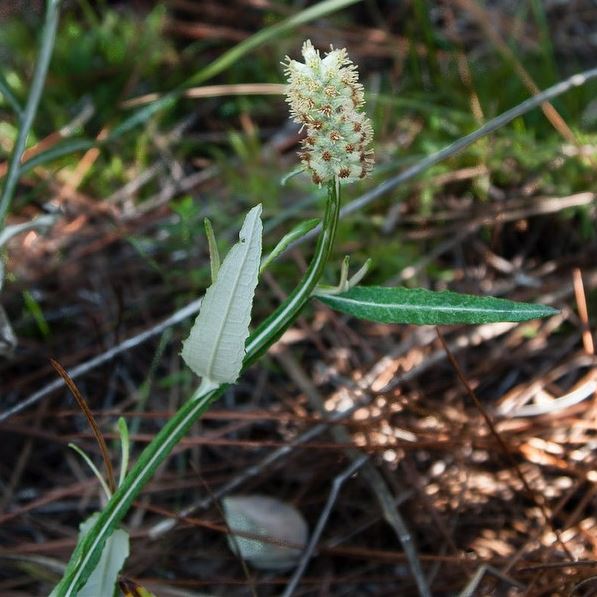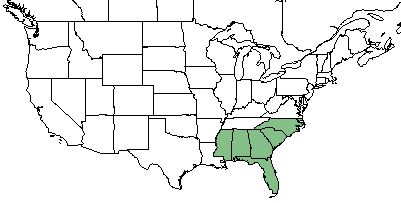Difference between revisions of "Pterocaulon pycnostachyum"
(→Ecology) |
|||
| Line 41: | Line 41: | ||
<!--===Seed dispersal===--> | <!--===Seed dispersal===--> | ||
<!--===Seed bank and germination===--> | <!--===Seed bank and germination===--> | ||
| − | + | ===Fire ecology=== | |
| + | ''P. pycnostachyum'' has been observed blooming in a recently burned pine flatwoods. .<ref name ="FFE">Observation by Alex de la Paz in UCF Arboretum, Orange County, FL, March 2018, posted to Florida Flora and Ecosystematics Facebook Group March 24, 2018. </ref> | ||
| + | <!--Fire tolerance, fire dependence, adaptive fire responses--> | ||
<!--===Pollination===--> | <!--===Pollination===--> | ||
<!--===Use by animals===--> <!--Herbivory, granivory, insect hosting, etc.--> | <!--===Use by animals===--> <!--Herbivory, granivory, insect hosting, etc.--> | ||
Revision as of 13:01, 29 June 2018
Common names: dense-spike blackroot [1], wand or coastal blackroot, rabbit tobacco[2]
| Pterocaulon pycnostachyum | |
|---|---|

| |
| Photo by John Bradford hosted at Bluemelon.com/poaceae | |
| Scientific classification | |
| Kingdom: | Plantae |
| Division: | Magnoliophyta - Flowering plants |
| Class: | Magnoliopsida - Dicots |
| Order: | Asterales |
| Family: | Asteraceae |
| Genus: | Pterocaulon |
| Species: | P. pyconstachyum |
| Binomial name | |
| Pterocaulon pycnostachyum (Michx.) Elliot | |

| |
| Natural range of Pterocaulon pycnostachyum from USDA NRCS Plants Database. | |
Contents
Taxonomic Notes
Synonym: P. undulatum (Walter) C. Mohr
Variety: none
Description
P. pycnostachyum is a perennial forb/subshrub of the Asteraceae family that is native to North America. [1]
Distribution
P. pycnostachyum is found in Florida, Georgia, South Carolina, North Carolina, Alabama, and Mississippi in the eastern United States. [1]
Ecology
Habitat
Natural habitats for the P. pycnostachyum include sandhillas, dry pinelands, dry praire, and pine flatwoods. [3] [2] Specimens have been collected from bay forests, pine savannas, bog remnants, loose sand on burned pine flatwoods, longleaf pine regions, dry scrub woods, wiregrass savanna, coastal hammock, cypress flatwoods, moist savannas, slash pine palmetto, cyrillo swamp, and open pine flatwoods. [4]
Pterocaulon pycnostachyum can be found in the same habitats as Deeringothamnus rugelii, Asclepias pedicellata, Aristida beyrichiana, Asimina reticulata, Cuthbertia ornata, Galactia elliotti, Lygodesmia aphylla, and Pinus palustris. [5]
Phenology
Flowering occurs in June. [6]
Fire ecology
P. pycnostachyum has been observed blooming in a recently burned pine flatwoods. .[7]
Conservation and Management
Cultivation and restoration
Photo Gallery
References and notes
- ↑ 1.0 1.1 1.2 USDA Plant Database
- ↑ 2.0 2.1 Orzell, S. L. and E. L. Bridges (2006). "Floristic composition of the south-central Florida dry prairie landscape." Florida Ecosystem 1(3): 123-133.
- ↑ Weakley, A. S. (2015). Flora of the Southern and Mid-Atlantic States. Chapel Hill, NC, University of North Carolina Herbarium.
- ↑ URL: http://herbarium.bio.fsu.edu. Last accessed: June 2018. Collectors: A.e. Radford, R.Kral, Sidney McDaniel, Joe Sparling, D.L. Fichtner, R.K.Godfrey, A>F. Harris, K. Draddock Burks, Loran Anderson, B.L. Turner, Elmar Prichard, Mary Margaret WIlliams, Robert Lazor, Delzie Demaree, Lovette E. Williams, A.F. Clewell, R.L. Wilbur, Paul Lemon, Mary Atkinson, LB Trott, Robert Lemaire, J. N. Triplett Jr., Gwynn Ramsey, Richard Mitchell, Roomie Wilson, M. Davsi, CC ALbers, Fred Barkeley, K.M. Meyers, A. Townesmith, Wayne D. Longbottom, David Williams, S. Taylor, Janice Weems. States and counties: South Carolina (Lee) FLroida (Levy, Citrus, Washington, Baker, Leon, Liberty, Escambia, jefferson, Walton, Clay, Volusia, Polk, Wakulla, Franklin, Bay, Hamilton, Broward, Putnam, Okeechobee, ALachua, Taylor, Orange, Seminole, Sarastota) Georgia (Charlton, Ware, Brooks, Berrien, McIntosh, Thomas, Bulloch) Louisiana (Calcasieu) Texas ( Bastrop).
- ↑ [Canfield, S. L. and G. W. Tanner (1997). "Observations of pinywoods dropseed (Sporobolus junceus) phenological development following fire in a sandhill community." Florida Scientist 60(2): 69-72.]
- ↑ Pan Flora
- ↑ Observation by Alex de la Paz in UCF Arboretum, Orange County, FL, March 2018, posted to Florida Flora and Ecosystematics Facebook Group March 24, 2018.